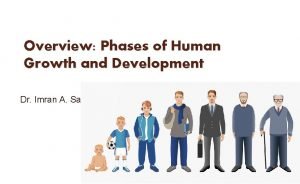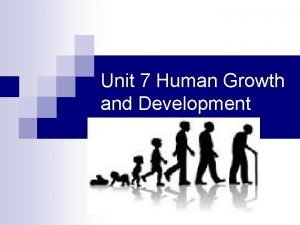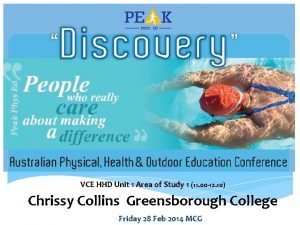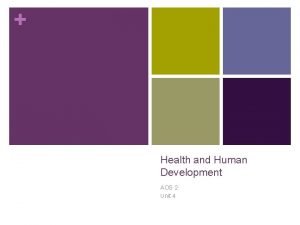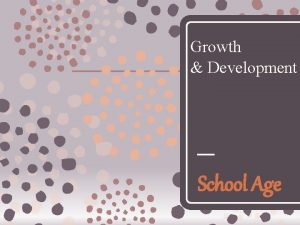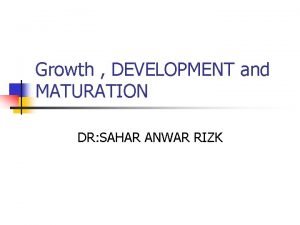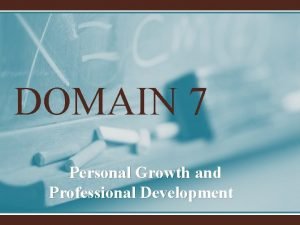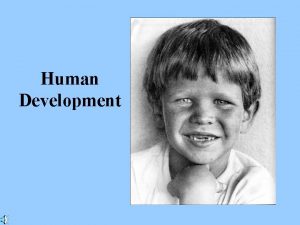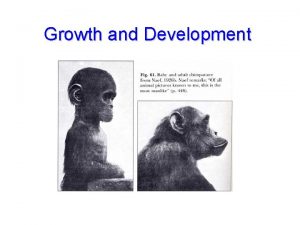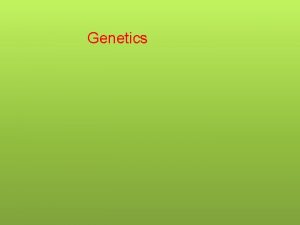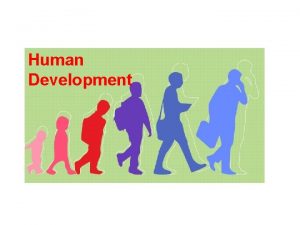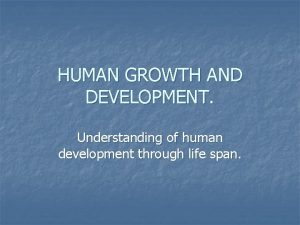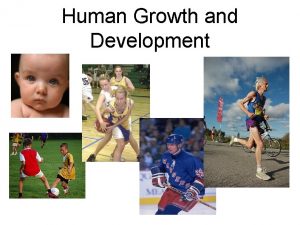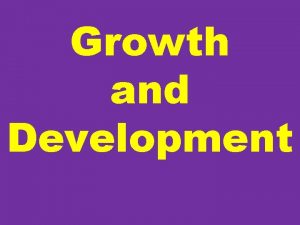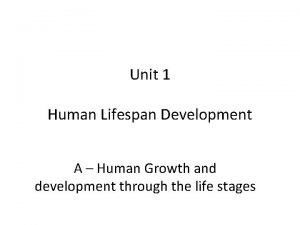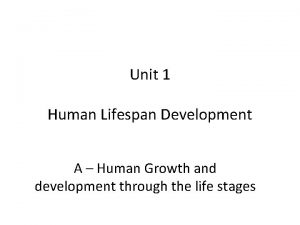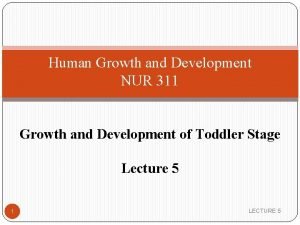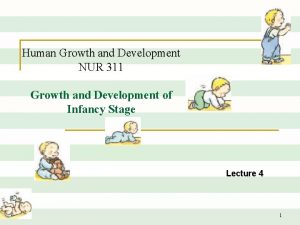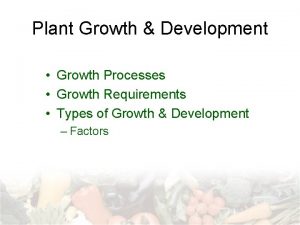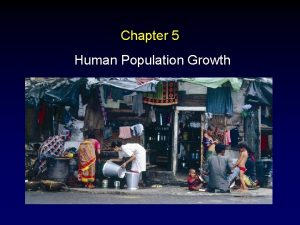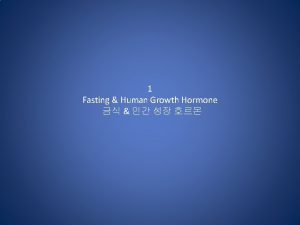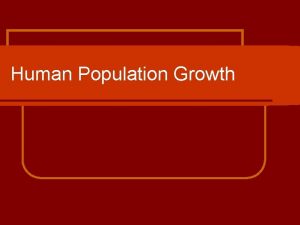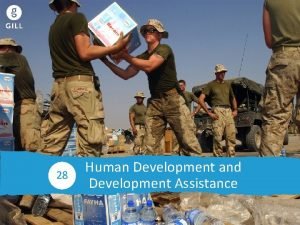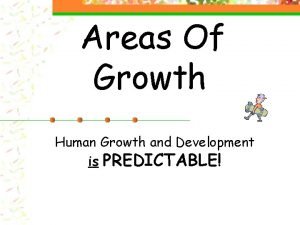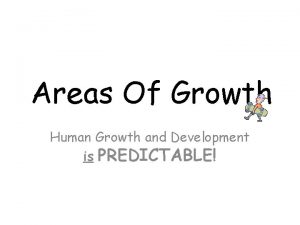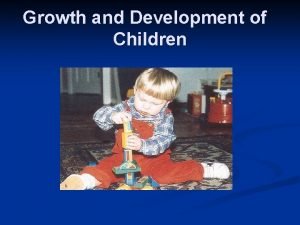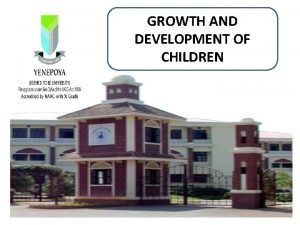Unit 7 Human Growth and Development 7 1

























- Slides: 25

Unit 7 Human Growth and Development

7: 1 Life Stages Growth and development begins at birth and ends at death n During an entire lifetime, individuals have needs that must be met n Health care workers need to be aware of the various stages and needs of the individual to provide quality health care n

Life Stages Infancy: birth to 1 year n Early childhood: 1 -6 years n Late childhood: 6 -12 years n Adolescence: 12 -20 years n Early adulthood: 20 -40 years n Middle adulthood: 40 -65 years n Late adulthood: 65 years and up n

Four main types of Growth and Development Physical: body growth n Mental: mind development n Emotional: feelings n Social: interactions and relationships with others n All four types above occur in each stage n

Erikson’s Stages of Psychosocial Development Erikson was a psychoanalyst who identified eight stages of psychosocial development n For each stage a basic conflict or need must be met n See Table 7 -1 in text n

Infancy n n n Age: birth to 1 year old Conflict – Trust vs. Mistrust Dramatic and rapid changes Physical development– roll over, crawl, walk, grasp objects Mental development—respond to cold, hunger, and pain by crying. Begin to recognize surroundings and become aware of surroundings and people

Infancy Emotional development – show anger, distrust, happiness, excitement, etc. n Social development – self-centeredness https: //www. youtube. com/watch? v =VSf-6 xzn. Jyk&feature=relmfu concept of the newborn to recognition of others in their environment n ¨ Infants are dependent on others for all needs

VIDEOS 24 hrs with a newborn n https: //www. youtube. com/watch? v=m 9 Qnd. NXcn. CU&feat ure=watch 6 weeks baby https: //www. youtube. com/watch? v=GSB 07 bshba. E Baby Learning to Walk n https: //www. youtube. com/watch? v=I 8 s. Yot. POu 60 14 months https: //www. youtube. com/watch? v=f 4 X 85 FJVd. DY&feature= relmfu

Early Childhood n n Age: 1 -6 years old Conflict: Toddler 1 to 3 years - Autonomy vs. shame and doubt ¨ Preschool 3 to 6 years – Initiative vs. guilt ¨ n n Physical development – growth slower than in infancy. Muscle coordination allows the child to run, climb, move freely. Can write, draw, use a fork and knife Mental development – verbal growth progresses, short attention span, at end of stage ask questions, recognize letters, and some words

VIDEOS 2 year old dancing https: //www. youtube. com/watch? v=4 wt 824 D 1 Bqg 3 yr old but Linda https: //www. youtube. com/watch? v=TP 8 RB 7 UZHKI Funny 4 year old https: //www. youtube. com/watch? v=Jo. Bx. Ffz 4 Dko

Late Childhood n n Age: 6 -12 years old Conflict – Industry vs. inferiority Physical development– slow but steady. Muscle coordination is well developed and children can engage in physical activity that require complex motor-sensory coordination Mental development – developing quickly and much of the child’s life centers around school. Reading and writing skills are learned, understand abstract concepts like honesty, loyalty, values and morals

Late Childhood n n Emotional development -- the child achieves greater independence and a more distinct personality. Fears are replaced by the ability to cope. Social development – changes from activities by themselves to more group oriented. They are more ready to accept the opinions of others and learn to conform to rules, and standards of behavior. Needs are the same as infancy and early childhood along with the need for reassurance, parental approval, and peer acceptance.

Adolescence n n n Age: 12 -20 years old Conflict – Identity vs. Role Confusion Physical development – growth spurts, muscle coordination slows. Development of sexual organs and secondary sexual characteristics (puberty). Secretion of sex hormones leads to the onset of menstruation in girls and the production of sperm and semen in boys. Body shape and form changes.

Adolescence n n Mental development – most foundations have been set. Development primarily involves an increase in knowledge and sharpening of skills. Learn to make decisions and accept responsibility for actions. Emotional development – emotional development is often stormy and in conflict. Adolescents try to establish their identities and independence. They respond more and more to peer group influences.

Adolescence https: //www. youtube. com/watch? v=w. JMXk 5 ibk. Qk n Social development – spending less time with family and more time with peer groups. They attempt to develop self-identity and independence and seek security from their peers. Toward the end of this stage they develop a more mature attitude and develop patterns of behavior that they associate with adult behavior. ¨ Need for reassurance, support and understanding. Problems that develop in this stage can be traced to conflict and feelings of inadequacy and insecurity.

Early Adulthood n n Age: 20 -40 years old Conflict Intimacy vs. Isolation Physical development – basically complete. Muscles are developed, strong and motor coordination is at its peak. Mental development – young adults seek additional education, choose careers and independence.

Early Adulthood Emotional development – Young adults are subjected to many emotional stresses related to career, marriage, family, etc. n Social development – moving away from peer group, and adults tend to associate with others who have similar ambitions. Most find a mate and begin a family. n n https: //www. youtube. com/watch? v=Pc 0 zy. HH 3 svg

Middle Adulthood n n Age: 40 -65 years of age Conflict – Generosity vs. Stagnation Physical development – Hair grey’s and thins, skin wrinkles, muscle tone decreases, hearing loss, visual acuity losses, weight gain. Mental development – can continue to increase. Confident decision makers and excellent at analyzing situations.

Middle Adulthood Emotional development – can be a period of contentment and satisfaction. n Social development -- Family relationships can decline as children begin lives of their own and parents die. Divorce rates are high. Friendships are with people with similar interests and lifestyles. n

Late Adulthood Age: 65 years of age and up n Conflict – Ego integrity vs. despair n Physical development – on the decline. Skin becomes dry and wrinkles, “age spots” appear. Hair thins, muscles lose tone and strength. Memory loss can occur and reasoning ability can diminish. n

Late Adulthood n n n Mental development – varies. People who remain mentally active and are willing to learn new things tend to show fewer signs of decreased mental ability Emotional development – Emotional stability also varies. Social development – retirement can lead to loss of self esteem, lost identity. Death of spouse and friends cause changes in social relationships.

7: 3 Human Needs n n n Needs: lack of something that is required or desired Needs exist from birth to death Needs influence our behavior Needs have a priority status Maslow’s hierarchy of needs

Maslow’s hierarchy of needs

Meeting Needs Motivation to act when needs felt n Sense of satisfaction when needs met n Sense of frustration when needs not met n Several needs can be felt at the same time n Different needs can have different levels of intensity n

Methods for Satisfying Needs n Direct methods – meeting a need and obtaining satisfaction. ¨ Hard work ¨ Set realistic goals ¨ Evaluate situation ¨ Cooperate with others
 Stages of human growth and development pictures
Stages of human growth and development pictures Theories on growth and development
Theories on growth and development Stages of human development
Stages of human development Social development in middle adulthood
Social development in middle adulthood Human growth and development
Human growth and development Infancy psychosocial development
Infancy psychosocial development Hhd vcaa
Hhd vcaa 8.3 human needs
8.3 human needs Chapter 8 human needs and human development
Chapter 8 human needs and human development Absolute growth rate and relative growth rate
Absolute growth rate and relative growth rate Root hair structure
Root hair structure Primary growth and secondary growth in plants
Primary growth and secondary growth in plants Chapter 35 plant structure growth and development
Chapter 35 plant structure growth and development Health and human development unit 4 aos 2
Health and human development unit 4 aos 2 Gni definition ap human geography
Gni definition ap human geography Carothers equation
Carothers equation Geometric exponential growth
Geometric exponential growth Neoclassical growth theory vs. endogenous growth theory
Neoclassical growth theory vs. endogenous growth theory Difference between organic and inorganic growth
Difference between organic and inorganic growth Chapter 16 lesson 1 the endocrine system
Chapter 16 lesson 1 the endocrine system Pretest: growth, development, and sexuality
Pretest: growth, development, and sexuality Sahar anwar
Sahar anwar Stages of developmetn
Stages of developmetn Slidetodoc. com
Slidetodoc. com What is economic growth and development
What is economic growth and development Personal growth and professional development.
Personal growth and professional development.


